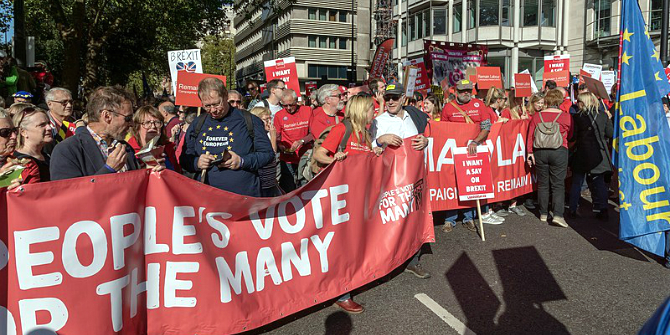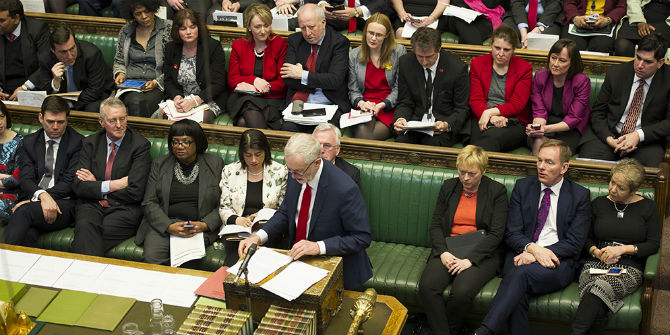 Tim Oliver (LSE Ideas) reviews The European Union in Crisis. He writes that this latest contribution dealing with the multi-dimensional nature of EU’s crisis offers a solid starting point to understanding a Union which over the past few years has been tested as it has never been before.
Tim Oliver (LSE Ideas) reviews The European Union in Crisis. He writes that this latest contribution dealing with the multi-dimensional nature of EU’s crisis offers a solid starting point to understanding a Union which over the past few years has been tested as it has never been before.
Politics is so often the routine of dealing with day-to-day emergencies that we can lose sight of what is and is not a crisis. It’s easy to fall into this trap and miss the bigger picture when entranced by the daily machinations of the Trump White House, the farcical week by week attempts to come to terms with what Brexit means, or the ongoing circus of the EU’s various problems. Yet there can be little doubt that the past few years have been a period of crisis for the European Union. While it’s often said the Union has been faced with many crises before (although see below for why this is not true), the one that began in 2009-10 with the onset of what became known as the Eurozone crisis has grown into a crisis of a much greater magnitude and danger than the Union has ever seen. As Rem Korteweg argued in 2015, the EU then appeared – and, perhaps, still does – to be surrounded by the four horsemen of the Apocalypse: Death’s harvesting of refugees and migrants in the Mediterranean put pressure on Schengen; War haunted Eastern Europe, straining relations with Russia; Famine brought hardship and poverty to Southern Europe thanks to the Eurozone crisis; and Pestilence spread Euroscepticism from Britain thanks to the then forthcoming in/out referendum. For Dinan, Nugent and Paterson, the scale and danger can only be appreciated if the crisis is seen as a multidimensional one playing out at many different levels: it is internal and external; economic, political, and social; core and periphery; transient and possibly permanent.

It’s difficult to highlight particular chapters from a book so rich in analysis and wide-ranging in topics covered. The multi-dimensional nature of the crisis is outlined at the start, followed by Desmond Dinan’s chapter ‘Crises in EU history’ dismissing the idea that crises have been the driving force of European integration. For Dinan, this idea has been so deeply woven into the narrative of the EU’s history that it has left many complacent of the real dangers the current crisis poses. Instead, many hold onto a myopic belief that the EU can both survive and prosper from the current crisis. The full severity of the crisis is fully exposed in the ensuing chapters. The big three – Eurozone, Schengen and Brexit – are comprehensively analysed from many different perspectives. In addition to being covered in their own chapters, they are also the focus in many of the other chapters, a reminder of how interconnected this crisis is.
Other chapters cover topics that are large enough to warrant individual books themselves: the wider crisis in the political economy of Europe and the West; the core-periphery tensions straining the unity of the Union; the challenge of a fiscal federation to deal with the crisis; the strengths and weaknesses of the EU’s institutions; the legitimacy challenge such as the Troika and the dangers of coercive Europeanisation; the place of Germany as the ‘indispensible power’, but one that has struggled to get its way; the future of Greece in the EU; the uncertain role of newer members from Central and Eastern Europe; the instability in Eastern Europe surrounding developments in Ukraine and with Russia; the global perceptions of an EU seen as weak and declining, and which despite being born from geopolitical tensions has struggled to grasp the continued relevance of geopolitical thinking and hard power; and finally the theoretical approaches to understanding the whole mess and whether or not the EU can survive. Whether the causes of the crisis are endogenous or exogenous, self-inflicted or the result of unforeseen flaws, the fraying of solidarity, declining trust, and deepening divergences over the way forward are recurring themes throughout. So too is woeful leadership, wishful thinking, and poor planning. As the editors argue (on page 7) of two of the main parts of the crisis: ‘Like EMU, Schengen had been designed from the perspective of hoping for the best rather than anticipating the worst. When the worst happened, the system was unable to cope.’
There is something in this book for every student and researcher of the EU
The book then is a good guide for those struggling to contain and control the crisis, whether they are officials of national governments or of the EU, campaigners or members of the public. Anybody studying one aspect of the crisis, for example, the Eurozone or Brexit, would be well served by this book as it locates each aspect within the wider crisis of which it forms but one part. Students of some individual member states – Germany, Britain, France, Greece and some Central and Eastern European countries – will find them more than adequately covered. There is something in this book for every student and researcher of the EU. Those researching crises – not least how complex international organisations such as the EU respond to them – are, of course, well served. It’s also of help to any student of international relations, comparative politics, economics, philosophy, risk, European history, or of the individual states of Europe.
the EU is not ‘Europe’ in much the same way the USA is not ‘America’
As Europe’s predominant organisation for politics, economics, social matters and non-traditional security, the state the EU is in matters a lot for Europeans. But we should remember that the EU is not ‘Europe’ in much the same way the USA is not ‘America’. In looking at the EU, the book, therefore, touches on but never focuses on some of the deeper problems – crises? – facing Europe: its demographics; the struggle to maintain various welfare models; the future of democracy and universal values Europe has held dear but seems increasingly filled with self-doubt over promoting; investments in infrastructure, science, digitisation, military technology and productivity; environmental challenges; questions surrounding Europe’s mix of identities, religions and ethnicities. All of the chapters touch on some of these deeper problems, with some chapters doing so more than others. For example, Ben Rosamond’s examination of the political economy of the crises points to wider tensions surrounding the changing relationships between the state, capitalism and democracy in Europe and the wider West. Of course, we can often forget that other regions and states face equally large if not larger crises. The political system of the USA can hardly be said to be in great shape because of the tensions Donald Trump’s election have unleashed. Russia, China and India are all wrestling with their own demographic problems. Efforts at cooperation between the countries of continents such as Africa or South America are bogged down.
While the crises these other countries and regions face pose significant challenges, few doubt the future existence of the likes of Russia, China or the USA. With Europe’s deeper problems lurking beneath the EU’s own problems, it should not surprise that the question of the EU’s long-term survival has frequently been raised. In the past year Brexit, Trump, the defeat of Le Pen and economic growth have boosted the EU, throwing doubt on the more pessimistic views of its future. It could be that the EU is emerging from what in 2013 Tom Wright of Brookings termed Europe’s lost decade. However, as Wright made clear back in the middle of that decade, the EU had three ways forward: integration, muddling through or disintegration. Five years on and, as The European Union in Crisis makes clear, the ‘muddling through’ option has been the course so far taken. Whether this will change or be sustained depends on two factors, which Douglas Webber identifies in his penultimate chapter. First, whether pro-European parties can continue to prevail in the domestic politics of the remaining 27 member states. Second, whether the Union can avoid a ‘crisis made in Germany’. Germany might have caused crises for the Union; its behaviour over the migration crisis, the Eurozone, or – as Webber hints at – over Brexit often being a key part of each of those problems. But Germany itself has never doubted its commitment. Such a crisis would strike at the heart of the Union. What disintegration might then lead to is difficult to say. Perhaps, should the EU head in that direction, then the best hope is the idea Webber ends on of ‘differentiated disintegration’ whereby, ‘individual member states leave the EU entirely, or withdraw, or are expelled from specific EU institutions; or some issue areas are – de jure or de facto – renationalised and/or the authority of supranational organs vis-à-vis national ones grows weaker.’ Of course, there are limits to how much – if at all – political science can predict the future. The European Union in Crisis does, however, offer a solid starting point to understanding a Union which over the past few years has been tested as it has never been before.
This article gives the views of the author, and not the position of LSE Brexit, nor of the London School of Economics.
Dr Tim Oliver is an Associate at LSE IDEAS, a Teaching Fellow at UCL and Director of Research at Brexit Analytics.







What crisis? Clearly terrorism and political unrest is not new to the Continent – in fact from the C19 it has been a major component of the progress towards the system of modern nation states and ordered civil societies we see today. I doubt whether a conservative evolutionary and rigid country hide bound by tradirion such as the UK can survive in that company – hence the retreat. Are the recent growth figures in the EU which have resulted from far less unhealthy quantitative easing abd printing money than in the UK or USA a sign of crisis? I think not. Those looking for crisis should look closer to home with a collapsing exchange rate and economic growth petering out on the back of a fall in consumer confidence, inevitable inflation, very poor productivity and low wages.
Recent data from Norway’s statistical office revealed that 50% of all jobs will require a masters degree in the next 10 years, while unskilled jobs will shrink to 5%.[1]
Education and training featured far more in the recent Norwegian election campaign than it did during the UK’s three months ago despite, as you point out, the low wage economy. When higher education is discussed in newspaper comment sections (below-the-line) the argument tends to be youngsters are wasting their time and money going to university.
[1] http://www.universityworldnews.com/article.php?story=20170113143451542